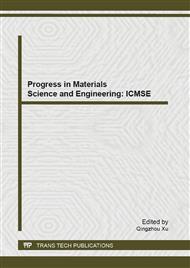p.73
p.80
p.86
p.93
p.99
p.104
p.112
p.116
p.121
Direction Finding of Multiple Coherent Signals Based on Frequency Domain Sample Process
Abstract:
In the field of communication direction finding by using antenna array, multi path effect arouses great attention. It not only increases the number of arriving waves, but the multi arriving signals are coherent. In order to solve the problem brought by multi path effect, much more elements are needed for multi arrival direction estimation after cancelling coherence processing which also requires more elements by spatial smoothing method. The method of frequency domain process is used in this paper to reduce the coherence between signals. The principal reason is that there is various wave distance difference between the multi arriving waves. The phase lag is not the same for different arriving path. Therefore we can adopt wide band receive process. The spatial vectors for different frequency component are not coherent, so it needs less elements for the array in the same case. The simulation results prove it is practical.
Info:
Periodical:
Pages:
99-103
Citation:
Online since:
October 2013
Authors:
Price:
Сopyright:
© 2013 Trans Tech Publications Ltd. All Rights Reserved
Share:
Citation:


